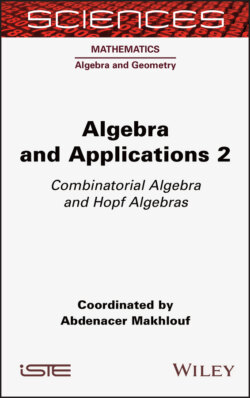Читать книгу Algebra and Applications 2 - Группа авторов - Страница 39
1.6.2. A pedestrian approach to free pre-Lie algebra
ОглавлениеIn this section we give a direct proof of Theorem 1.4 without using operads. It is similar to the proof of the main theorem in Chapoton and Livernet (2001) about the structure of the pre-Lie operad, except that we consider unlabeled trees. We stick to d = 1 (i.e. one generator), the proof for several generators being completely analogous. Let be the vector space spanned by rooted trees. First, the grafting operation is pre-Lie, because for any trees s, t and u in , the expression:
[1.80]
is obtained by summing up all of the possibilities of grafting s and t at some vertex of u. As such, it is obviously symmetric in s and t. Now let (A, ⊳) be any left pre-lie algebra, and choose any a ∈ A. In order to prove Theorem 1.4 for one generator, we have to show that there is a unique pre-Lie algebra morphism , such that Fa(•) = a. For the first trees, we easily obtain:
Can we continue like this? We proceed by double induction, first, on the number of vertices, second, on the number of branches, that is, the valence of the root. Write any tree t with n vertices as t = B+ (t1,…, tk), where the tjs are the branches and B+ is the operator that grafts the branches on a common extra root. By the induction hypothesis on n, the images Fa(tj) are well-defined.
Suppose first that k = 1, that is t = B+(t1) = t1 → •. Then, we obviously have Fa(t) = Fa(t1) ⊳ a. Suppose now that Fa(s) is unambiguously defined for any tree s with n vertices and k′ branches with k′ ≤ k – 1. The equation:
shows that, if Fa(t) exists, it is uniquely defined by:
[1.81]
What remains to be shown is that this expression does not depend on the choice of the distinguished branch t1. In order to see this, choose a second branch (say t2), and consider the expression:
[1.82]
which is obtained by grafting t1 and t2 on B+(t3, … , tk). This expression is the sum of five terms:
1 1) T1, obtained by grafting t1 and t2 on the root. It is nothing but the tree t itself.
2 2) T2, obtained by grafting t1 on the root and t2 elsewhere.
3 3) T3, obtained by grafting t2 on the root and t1 elsewhere.
4 4) T4, obtained by grafting t1 on some branch and t2 on some other branch.
5 5) T5, obtained by grafting t1 and t2 on the same branch.
The terms Fa(T2) + Fa(T3), Fa(T4) and Fa(T5) are well-defined by the induction hypothesis on the number of branches, and are obviously symmetric in t1 and t2. We thus arrive at:
which is symmetric in t1 and t2 thanks to the left pre-Lie relation in A. The expression [1.81] is then the same if we exchange t1 with the branch t2 or any other branch; hence, it is invariant by any permutation of the branches t1,…, tn. This proves Theorem 1.4 for one generator. The general case is proven similarly, except we have to replace a ∈ A by a collection {a1,…,ad}.
